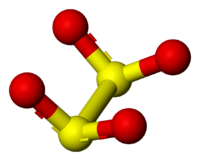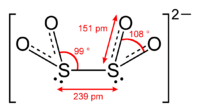Chemistry:Dithionite

The dithionite is the oxyanion with the formula [S2O4]2−.[1] It is commonly encountered as the salt sodium dithionite. For historical reasons, it is sometimes called hydrosulfite, but it contains no hydrogen and is not a sulfite.[2] The dianion has a steric number of 4 and trigonal pyramidal geometry.
Production and reactions
In its main applications, dithionite is generally prepared in situ by reduction of sulfur dioxide by sodium borohydride, described by the following idealized equation:.[3]
- NaBH
4 + 8 SO
2 + 8 NaOH → 4 Na
2S
2O
4 + NaBO
2 + 6 H
2O
Dithionite is a reducing agent. At pH 7, the potential is −0.66 V vs NHE. Redox occurs with formation of sulfite:[4]
- S2O2−4 + 2 H2O → 2 HSO−3 + 2 e− + 2 H+
Dithionite undergoes acid hydrolytic disproportionation to thiosulfate and bisulfite:[2]
- 2 S2O2−4 + H2O → S2O2−3 + 2 HSO−3
It also undergoes alkaline hydrolytic disproportionation to sulfite and sulfide:[2]
- 3 Na2S2O4 + 6 NaOH → 5 Na2SO3 + Na2S + 3 H2O
It is formally derived from dithionous acid (H2S2O4), but this acid does not exist in any practical sense.
Use and occurrence
Sodium dithionite finds widespread use in industry as a reducing agent. It is for example used in bleaching of pulp and some dyes.[3]
Niche
Dithionite is used in conjunction with complexing agents (for example, citric acid) to reduce iron(III) oxy-hydroxide into soluble iron(II) compounds and to remove amorphous iron(III)-bearing mineral phases in soil analyses (selective extraction).
The decomposition of dithionite produces reduced species of sulfur that can be very aggressive for the corrosion of steel and stainless steel. Thiosulfate (S2O2−3) is known to induce pitting corrosion, whereas sulfide (S2−, HS−) is responsible for stress corrosion cracking (SCC).
References
- ↑ International Union of Pure and Applied Chemistry (2005). Nomenclature of Inorganic Chemistry (IUPAC Recommendations 2005). Cambridge (UK): RSC–IUPAC. ISBN:0-85404-438-8. p. 130. Electronic version.
- ↑ 2.0 2.1 2.2 José Jiménez Barberá; Adolf Metzger; Manfred Wolf (2000). "Ullmann's Encyclopedia of Industrial Chemistry". Ullmann's Encyclopedia of Industrial Chemistry. Weinheim: Wiley-VCH. doi:10.1002/14356007.a25_477.
- ↑ 3.0 3.1 Wietelmann, Ulrich; Felderhoff, Michael; Rittmeyer, Peter (2016-09-29). "Hydrides". Ullmann's Encyclopedia of Industrial Chemistry. Weinheim, Germany: Wiley-VCH Verlag GmbH & Co. KGaA. doi:10.1002/14356007.a13_199.pub2. ISBN 978-3-527-30673-2. OCLC 751968805.
- ↑ Mayhew, S. G. (2008). "The Redox Potential of Dithionite and SO2− from Equilibrium Reactions with Flavodoxins, Methyl Viologen and Hydrogen plus Hydrogenase". European Journal of Biochemistry 85 (2): 535–547. doi:10.1111/j.1432-1033.1978.tb12269.x. PMID 648533.
 |


